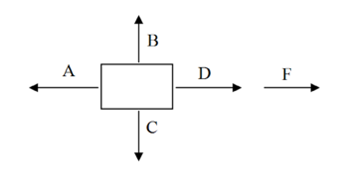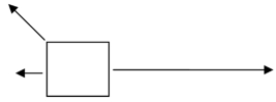A) Changing an object from a state of rest to a state of motion
B) Changing an object's speed without changing its direction of motion
C) Maintaining an object in motion at a constant velocity
D) Maintaining an object in uniform circular motion
E) Changing an object's direction of motion without changing its speed
Correct Answer

verified
Correct Answer
verified
Multiple Choice
A child, whose weight is 150 newtons, lifts a pumpkin from the ground with a force of 50 newtons. The force the pumpkin exerts on the child is
A) more than 50 newtons.
B) 50 newtons.
C) greater than zero but less than 50 newtons.
D) zero.
Correct Answer

verified
Correct Answer
verified
Multiple Choice
A parachutist jumping from an airplane reaches a terminal velocity when the force of air resistance is 980 N. The mass of the parachutist is
A) 220 lb.
B) 980 lb.
C) 980 kg.
D) 100 lb.
E) 100 kg.
Correct Answer

verified
Correct Answer
verified
Multiple Choice
In the diagram below, a force acting on a block is shown by the arrow labeled F. The mass of the block is known, as is the size of the force, but the observed acceleration is larger than F/m and so another force must act on the block. In which direction (A, B, C, or D) is this force?

A) A
B) B
C) C
D) D
Correct Answer

verified
Correct Answer
verified
Multiple Choice
A body sliding on a table is observed to gradually slow down. The correct statement is that the body slows down because
A) no force acts on the body.
B) no net force acts on the body.
C) it is the nature of the body to slow down by itself.
D) a net force acts on the body.
Correct Answer

verified
Correct Answer
verified
Multiple Choice
The surface gravity of Mars is 3.7 m/s2. If a person with mass of 100 kg were parachuting on Mars, what would be the force exerted by air resistance at terminal velocity?
A) 980 N
B) 490 N
C) 370 N
D) 100 N
Correct Answer

verified
C
Correct Answer
verified
Multiple Choice
A physics professor places a soda pop can on the table and asks a student to identify the forces acting upon the can and the directions of each force. The two forces acting on the soda pop can are
A) the weight force downward and normal force from the table downward.
B) the weight force downward and normal force from the table upward.
C) the weight force upward and normal force from the table downward.
D) the weight force upward and normal force from the table upward.
Correct Answer

verified
Correct Answer
verified
Short Answer
A light body and a heavy body are both given identical accelerations. The body acted upon by the larger force is the ________________ body.
Correct Answer

verified
Correct Answer
verified
Multiple Choice
A certain force causes a 50 kg person to accelerate at 1.0 m/s2. The same force applied to a 75-kg person would cause
A) a greater acceleration.
B) the same acceleration.
C) a smaller acceleration.
Correct Answer

verified
Correct Answer
verified
Multiple Choice
Suppose one's hand exerts a force of 12 N upward on a book weighing 10 N. The reaction to the force of the hand on the book is a force of
A) 10 N exerted by the Earth on the book.
B) 10 N exerted by the book on the Earth.
C) 12 N exerted by the book on the hand.
D) 10 N exerted by the book on the hand.
E) 2 N exerted by the book on the hand.
Correct Answer

verified
Correct Answer
verified
Multiple Choice
A 10-pound sack of potatoes falls from an airplane. As the velocity of the falling sack increases, so does the air resistance on it. When the air resistance equals 10 pounds, the acceleration of the sack will be
A) 100 ft/s2.
B) 9.8 m/s.
C) 9.8 m/s2.
D) zero.
Correct Answer

verified
D
Correct Answer
verified
Short Answer
A blob of green cheese at the Cheese Institute on the Earth has a mass of 8.1 kg. The same cheese blob in outer space will have a mass of ____________ kg.
Correct Answer

verified
Correct Answer
verified
Multiple Choice
A father and his young daughter are on very clean ice, so there is very little friction (the father has more mass than the daughter) . The father pushes his daughter forward and she slides away at a speed of 3 m/s. The father's velocity is
A) smaller than 3 m/s in the opposite direction as his daughter.
B) zero.
C) smaller than 3 m/s in the same direction as his daughter.
D) 3 m/s in the same direction as his daughter.
E) 3 m/s in the opposite direction as his daughter.![]()
Correct Answer

verified
Correct Answer
verified
Multiple Choice
In the trajectory of a thrown object, like a baseball, the weight force is always downward. However, the force of air resistance is always
A) upward.
B) horizontal.
C) tangent to the trajectory and in the direction opposite the velocity.
D) perpendicular to the trajectory.
Fill in the Blank Questions
Correct Answer

verified
Correct Answer
verified
Multiple Choice
Two pieces of kryptonite, #1 and #2, have identical masses, but the net force applied to #1 is 400 N and to #2 is 20 N. The acceleration
A) of #1 is larger.
B) of each piece of kryptonite is the same.
C) of #2 is larger.
D) depends on the weight of each piece of kryptonite.
Correct Answer

verified
A
Correct Answer
verified
Multiple Choice
Three forces act on the object in the sketch. In what direction will the object move? 
A) Upward
B) To the left
C) To the left and up
D) To the right
E) To the right and up
Correct Answer

verified
Correct Answer
verified
Multiple Choice
The erroneous idea that an object needs a force on it to keep moving even at constant velocity was held by
A) Aristotle.
B) Galileo.
C) Newton.
Correct Answer

verified
Correct Answer
verified
Short Answer
The net force acting on a body gives the direction of the ________________ of the body.
Correct Answer

verified
Correct Answer
verified
Multiple Choice
You stand on a scale to measure your weight. The reaction to the force the Earth exerts on you is
A) the force the scale exerts on you.
B) the force the Earth exerts on the scale.
C) the force you exert on the scale.
D) the force the scale exerts on the Earth.
E) the force you exert on the Earth.
Correct Answer

verified
Correct Answer
verified
Multiple Choice
The acceleration of gravity on the Moon's surface is about 1/6 of that on the Earth's surface. An object on the Earth is to be taken to the Moon. We can state that, compared to the Earth,
A) the object's mass and weight will be the same on the Moon.
B) the object's mass will be the same but the weight will be less on the Moon.
C) the object's mass will be less but the weight will be the same on the Moon.
D) the object's mass and weight will be less on the Moon.
Correct Answer

verified
Correct Answer
verified
Showing 1 - 20 of 52
Related Exams